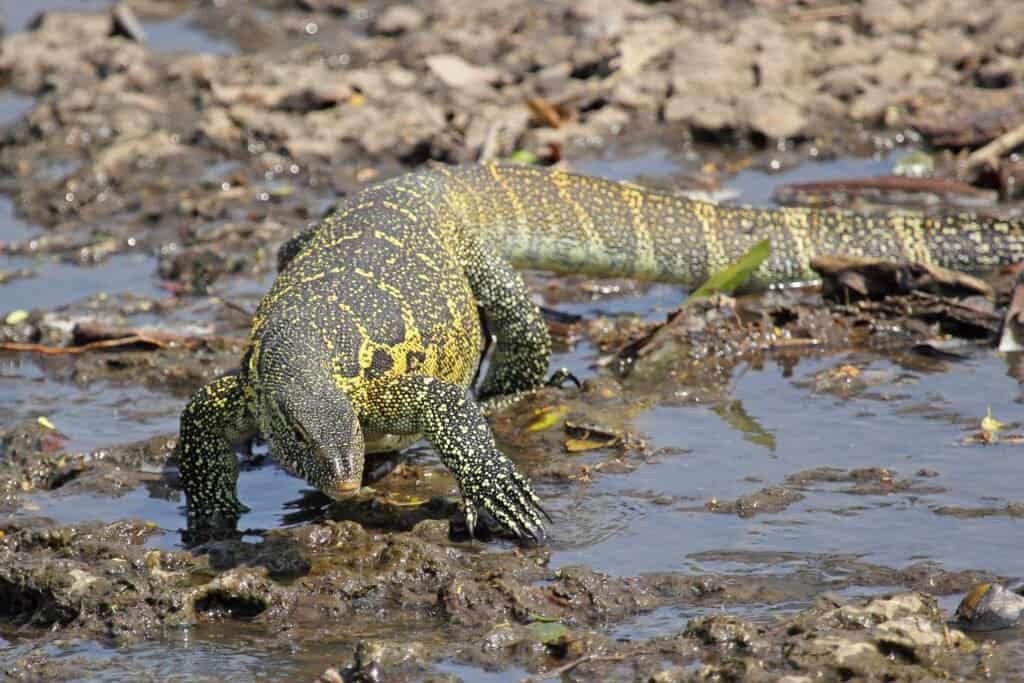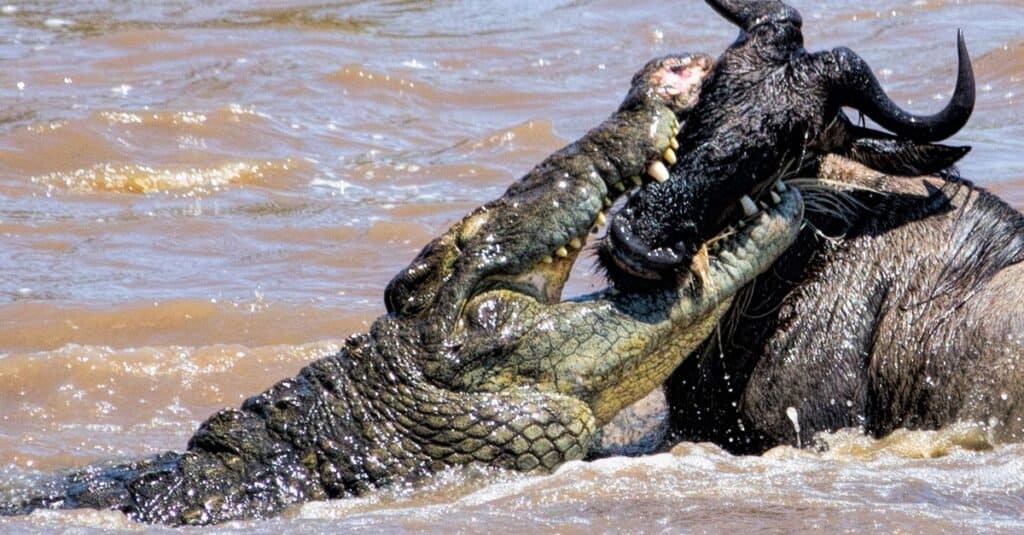There are a lot of species of reptiles, making them one of the world’s oldest and most diverse groups of animals. There are four main reptile groups, which include lizards, turtles, crocodilians (including both crocodiles and alligators), and snakes. One of the main characteristics that distinguish reptiles from mammals and birds is that they’re ectothermic, or “cold-blooded,”. This means that they rely on external factors, such as the weather, to power their bodies. In addition to their fascinating behavior, reptiles all have very different diets, making them even more interesting. Let’s learn all we can about what reptiles eat as well as how they hunt and forage for their food.
What Do Reptiles Eat?

Reptiles have a diverse diet since there are so many different species.
©MattiaATH/Shutterstock.com
Reptiles eat some form of animal food, such as insects, birds, frogs, sea creatures, mammals, fishes, and even other reptiles in some cases. There are so many different types of reptiles in the world, which means they can be classified as carnivores, omnivores, or herbivores based on their diets. Land tortoises, for example, eat leaves, grass, and, in some cases, cactus.
It’s important to note that some reptiles don’t always follow the norm regarding reptile nutrition. Sometimes, their diets are very unconventional. The Yellow Foot Tortoise, for example, eats crayfish and other invertebrates as well as other sources of meat. In addition to ocean plants, sea turtles will eat jellyfish and a number of other animals as well. Therefore, there is no one-size-fits-all reptilian diet.
Let’s look at a complete list of what reptiles eat now that we know what they eat.
A Complete List of Foods Reptiles Eat
A current estimate suggests that there are over 10,000 species of reptiles on earth. Among them are salad-loving turtles and huge crocodiles capable of snapping limbs off humans. As a result, reptile diets will be extremely diverse.
Here is a common list of foods that reptiles eat:
- Insects, including crickets, grasshoppers, worms, spiders, beetles, flies, and more.
- Fruits and vegetables such as apples, yellow squash, honeydew melons, strawberries, blueberries, collard greens, mangoes, peaches, pears, lettuce, and more
- Flowers
- Eggs
- Small animals such as mice, baby birds, small snakes, etc.
- Larger prey such as birds, frogs, fish, and other large mammals.
As a result of such a diverse diet, let’s take a look at how some reptiles hunt or forage for food.
How Do Reptiles Hunt & Forage For Food?

Crocodiles will stalk their prey and then capture them with their powerful jaws.
©Phil Hyde/Shutterstock.com
Due to their diverse diets, reptiles find their food differently. A great example is lizards, which use their sight, touch, smell, and hearing to find food. Lizards stick their tongues out to catch scent particles in the air, then pull them back and place them on the roof of their mouths, where they have sensory cells.
The primary method of finding food for carnivores and insectivores is by capturing prey. An attack on prey occurs either through a quick sprint followed by biting or through rapid movements of the head and neck. As an example, crocodiles hunt along swamps, rivers, and canals where unwary animals and birds drink and feed. To catch their prey, they sneak up on them, then catch it in their jaws and drag it into the water, where it drowns and gets eaten.
Turtles, on the other hand, often scavenge for food. It is because of their great sense of smell that they are able to hunt for food. Despite the appearance of leathery and tough skin, tortoises and turtles have extremely sensitive skin. Thanks to their sensitivity, it is possible for them to detect vibrations and changes in water pressure that indicate the presence of food or predators.
Insects and little animals are swallowed whole by carnivorous reptiles, while plants are swallowed whole by herbivorous reptiles. Digesting an entire animal, bones, and fur can all be difficult on their bodies.
What Do Pet Reptiles Eat?

A pet turtle is easy to feed as they rely on fruits and veggies mostly.
©My Good Images/Shutterstock.com
There are a lot of different kinds of lizards, as we’ve already mentioned. It is most common for smaller lizards to be insectivores. Other species of lizard, however, are herbivorous (plant-eating) or omnivorous (eating meat as well as vegetables). It is not uncommon for big lizards to be predators and to consume large mammals. Pets of this type aren’t very common, however.
Snakes, lizards, and turtles are among the most common reptile pets. Reptiles that are insectivorous are better suited for owners who are uncomfortable with feeding their pets mice. Crickets, mealworms, and waxworms are the most common foods of insectivorous pet lizards. When you have a pet turtle, you won’t need to prepare any stomach-turning meals for them. In most cases, turtles and tortoises will be happy eating a variety of fruits and vegetables along with fish or insects, depending on their species.
The snake, on the other hand, is typically a carnivore. Snakes in captivity typically eat mice or rats, although different species eat different diets. It is important to remember, however, that imbalanced diets and poor feeding management may result in nutritional disease in captive animals. According to a study published in Science Direct, there are a number of nutritional disorders that occur more commonly, such as metabolic bone disease from low calcium and vitamin D levels, hypovitaminosis A, and visceral and articular gout, caused by dehydration.
What do Baby Reptiles Eat?
Due to the fact that reptiles differ a lot, you can expect their babies to also eat quite different diets as well.
For example, when a baby snake is born, its diet isn’t that different from that of its parents, so it is not too difficult to understand. Baby snakes actually consume the same food as their parents do, with size being the most important factor when it comes to feeding them. Their main food source consists of tiny insects, small creatures, and eggs, and as long as they can fit inside their mouths, they will eat them.
By contrast, a wild baby lizard’s overall diet is highly dependent upon the availability and conditions under which the lizard is able to hunt prey. In order to survive in the wild, a baby herbivorous lizard is limited to only eating native plants, fruits, and vegetables found in its natural habitat.
You might be surprised to learn that in their early stages of development, turtles generally eat meat in order to maintain their growth. Their favorite protein sources include small insects, snails, worms, and fish. Their diet becomes increasingly plant-like as they grow.
The photo featured at the top of this post is © iStock.com/SteveByland
Thank you for reading! Have some feedback for us? Contact the AZ Animals editorial team.






